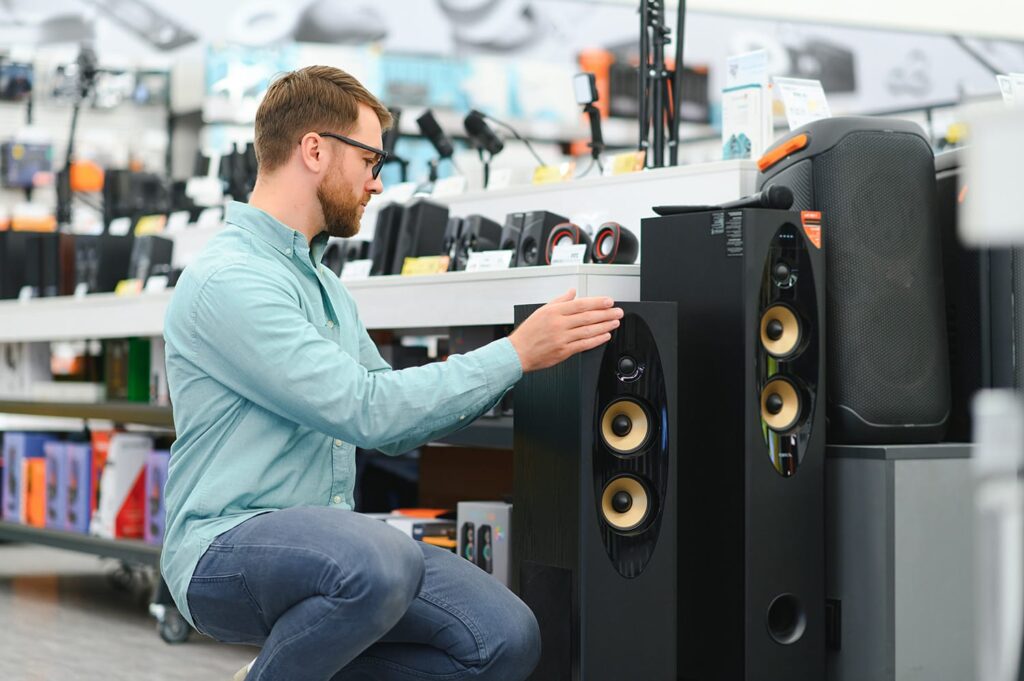
Ask ten home-theater fans and you’ll get ten confident answers. The right number isn’t a flex, it’s a fit—your room, your seat, and your patience.
What the numbers mean
Channel labels are a recipe: first number = ear-level speakers, second = subwoofers, third (if present) = height speakers for Atmos/DTS:X. So 5.1 is five speakers plus one sub. 5.1.2 adds two heights. 9.2.4 means nine ear-level speakers, two subs, and four heights. If you’re new to height audio, start with Dolby Atmos explained.
Start with the room, not the box
If your sofa hugs the back wall, rear surrounds in a 7.x or 9.x rig sit too close. If your ceiling is high or angled, up-firing modules struggle. Open-plan rooms often benefit from dual subwoofers to keep bass even across seats. Rule of thumb: fewer speakers placed well beat more speakers placed poorly. See best 5.1 speaker placement for quick wins.
Where each layout shines
3.1
Left, right, center, plus a sub. The center locks dialogue; the sub takes bass off your mains. If surrounds would land in awkward spots, 3.1 beats a messy 5.1.
5.1
The living-room sweet spot. Surrounds slightly behind and to the sides create believable wraparound. If you do one upgrade after 3.1, make it 5.1 vs 3.1—the jump is real.
7.1
Worth it when you have space behind the seats. Rear surrounds smooth pans from side to back. If your sofa is on the rear wall, skip to heights instead.
5.1.2
A great first step into Atmos. Two heights add a layer above you so rain falls and planes fly overhead. If your ceiling cooperates, 5.1.2 Dolby Atmos often beats 7.1 in modern mixes.
5.1.4
Four heights let sounds travel overhead front-to-back. Immersive without adding more ear-level speakers.
7.1.4
Side surrounds, rear surrounds, and four heights keep multiple seats equally engaged. You’ll need processing for eleven channels and possibly an external amp.
9.2.4
Adds front wides to bridge the gap between fronts and sides, plus two subs for even bass across seats. Stunning in treated rooms with the right electronics and patience.
Subwoofers: one or two?
One well-placed sub can be excellent. Two moderate subs placed apart are often better, smoothing boomy hot spots and thin zones. If you’re torn between more speakers or better bass, start with bass. Our subwoofer setup guide will save you time.
Power, processing, and calibration
AVRs list both how many channels they process and how many they amplify. Many process 11 or 13 but power fewer. Use pre-outs and add a small amp when you expand. Room correction matters as much as channel count. If you’re choosing electronics, compare Dirac Live vs Audyssey vs YPAO to see which calibration style fits you.
For real-world examples:
- Midrange with Dirac: Onkyo TX-RZ50 review
- Heavy-duty channel count with Audyssey XT32: Denon AVR-X8500HA review
- Living-room friendly with YPAO: Yamaha RX-A2A review
A simple upgrade path
- Nail the center and add a quality sub.
- Expand to 5.1 with correctly placed surrounds.
- Add two heights if the room allows.
- Add a second sub for even bass.
- Consider rear surrounds or four heights once the basics are dialed.
So, how many do you need?
For most homes, aim for 5.1 first. If your ceiling works, 5.1.2 is a bigger audible upgrade than 7.1. With space behind the couch, 7.1 adds polish. Dedicated rooms? 7.1.4 is a sweet destination, and 9.2.4 can be magic if you’re ready to commit. The system that fits your space and is set up thoughtfully will always sound bigger than the number on the box.






